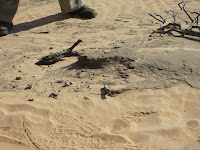Lake Mungo of Antiquity
 |
| Lakefront property no longer |
40,000 years ago our campsite would have been at the edge of a sprawling lake, the far shore some twenty kilometers in the distance. The animal life would have been a diverse group including hairy nosed wombats, red and grey kangaroos, bilbys and Tasmanian tigers. The last of the megafauna (essentially large versions of the above mentioned animals) would have already died out several thousand years before, because as the song goes, the times they are a changing.
The extinction of the giant varieties of wombat and kangaroo probably came about from a combination several factors including climate change and some new neighbors of the two-legged variety. The lake levels fluctuated some over the next 20,000 years until entering a drying phase and disappearing completely.
 |
| The lake bed today. The lunette is just visible on the horizon |
Today the dry lake bed is covered in low growing salt bushes. The wombats have moved on to greener pastures and the Tasmanian tigers have moved into the natural history museum. The red and grey kangaroos are still out in droves. Emus have moved in. The most recent neighbors are rabbits, feral cats and goats.
The most striking feature of the park is the 33-kilometer lunette (a crescent shaped dune making up the eastern shore of the lake). When the lake was full the prevailing westerly winds shaped the lake’s rounded shoreline. When the water levels dropped the same winds whipped up the lake’s sandy bottom and deposited it on the shoreline, gradually building up the eastern bank. Periodic fires would clear the vegetation allowing rain and wind to go to work carving up the unprotected lunette. Vegetation would grow back to hold the earth in place and the wall would continue to grow. Sand and silt were compacted into rock called silcrete as the layers grew.
 |
| Here you can see the Lunette in the foreground and curving around in the distance |
In the second half of the 19th century sheep and rabbits were introduced to the area. The land quickly became heavily degraded and the erosion of the lunette increased significantly. The upside of which was that several layers of buried history began to turn up.
Jean and I went on a tour of the lunette with a couple of the park rangers, Ernie and Ricky. Both are members of the local Barkindji Aboriginal group. “We like to think of this as our office,” Ricky told us at the foot of lunette.
 |
| Ernie pointing out the site of an ancient camp fire |
They led us up the hard packed striated surface. Crouching next to a patch of blackened earth strewn with pieces of bone and shell Ernie tells us that this is the scar from a campfire estimated to be 30,000 years old. The shells are from mussels and the bones are probably from a fish. Archeologists have discovered numerous campfire sites on the lunette. In many instances the scars left by the campfire run quite deep, indicating that they were used for long periods of time and probably over many generations.
Aboriginals would mold clay into balls and bury them in the fire to act as heat retainers. Coincidentally, the clay balls recorded the direction of the Earth’s magnetic field at the time of heating. This evidence suggests a near reversal in the earth’s magnetic field 30,000 years ago. A compass back then would have pointed to what we consider east south east today. The phenomenon has been called the Mungo excursion.
Evidence of prehistoric activity began to turn up everywhere once we began to look. Part of a wombat jaw jutting out of ravine wall, more mussel shells scattered across black marks in the earth. The most significant finds came in the early 1970’s. Several human skeletons were discovered by the anthropologist Jim Bowler. The skeletons are burned indicating some kind of burial ritual. There is still much debate regarding the age of the skeletons but they are estimated to be around 40,000 years old.
We followed Ricky and Ernie up over the crest of the lunette where the carved silcrete landscape turns to sand dunes. At a rest break Ernie took out his guitar and sang some songs about the history of the park, his life story and the Barkindji people.








Comments
I really enjoyed the stories with pictures of your adventure and look forward to seeing more.
Congratulations on your 2nd anniversary and 33rd birthday.